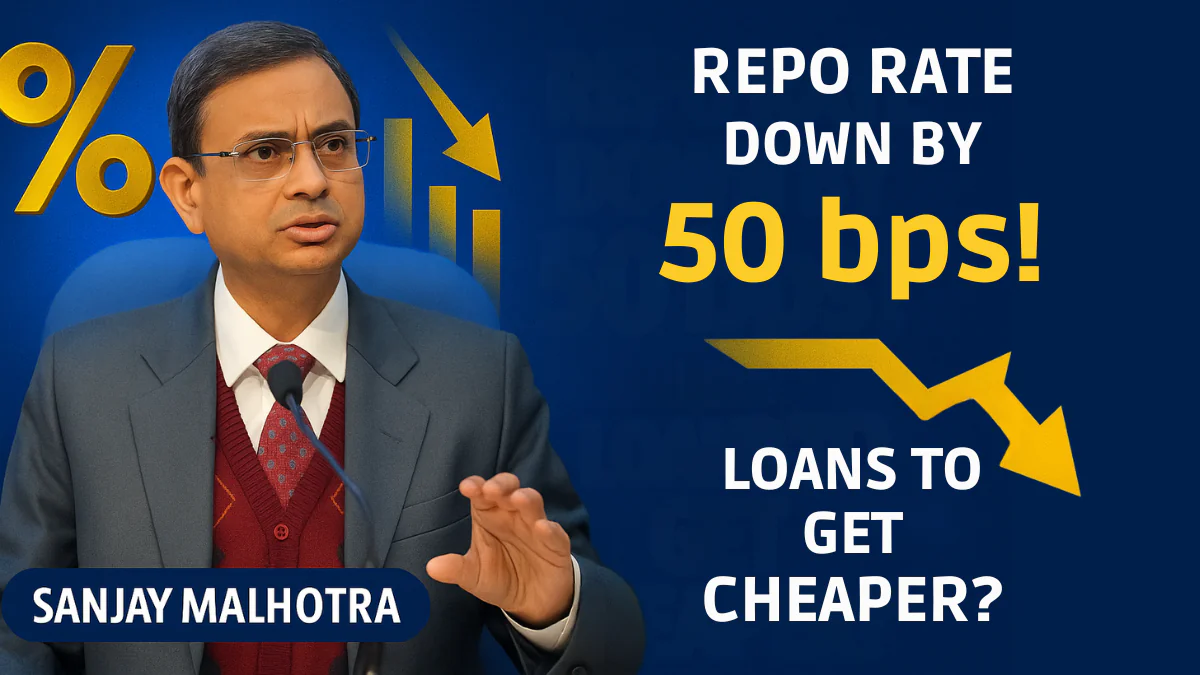RBI Cuts Repo Rate by 50 bps – 3rd Time in 6 Months!

Table of Contents
ToggleShare this article ↷
WellReturns is now on WhatsApp!
Get instant updates and expert tips.
Managing debt in India just got a bit easier, with the Reserve Bank of India (RBI) slashing the repo rate by 50 basis points (bps) to 5.5% on June 6, 2025. This marks the third rate cut in six months, following reductions in February (6.5% to 6.25%) and April (6.25% to 6%).
This decision involved lowering the rate by 50 basis points, or half a percentage point. The move aims to boost growth and support an economy that’s showing mixed signals. For borrowers, investors, and the economy, this new rate cut offers both opportunities and risks. Let’s break it down in a way that’s as simple as sipping chai.
Read also: Get a Loan Against Mutual Funds
Understanding the Repo Rate and Its Significance
What is the Repo Rate?
The repo rate is the interest rate at which RBI lends money to commercial banks. This rate helps control inflation and keeps the economy stable. When RBI lowers the repo rate, banks get cheaper funds. That should make lending cheaper for everyone, from home buyers to big companies. Think of it as the cost for banks to borrow money, which then trickles down to your loan payments.
Why the Repo Rate Matters?
The repo rate influences how much banks charge for loans. When it goes down, your interest on a home loan or car loan usually drops too. The rate changes also impact inflation – which is how fast prices rise. If interest rates are low, people tend to spend more. When rates are high, borrowing slows down. This creates a balance between inflation and growth.
How RBI’s Repo Rate Cut Affects Your Home Loan EMI
The repo rate is the interest rate at which the RBI lends money to commercial banks. When it drops, banks can borrow at a lower cost, and ideally, they pass this benefit to you. With the latest 50 bps cut, home loan interest rates could dip, making your monthly EMIs more affordable and debt management in India.
For example, if you have a ₹50 lakh home loan with a 20-year tenure at 9% interest, your EMI is around ₹44,986. A 0.5% rate cut could lower the interest to 8.5%, reducing your EMI to about ₹43,391, saving you roughly ₹1,595 per month. That’s extra cash for your Diwali shopping or a small SIP!
However, not all loans will see immediate relief. If your loan is linked to the repo rate (External Benchmark Lending Rate or EBLR), the reduction will reflect faster, typically within three months, as per RBI guidelines. Fixed-rate loan holders, though, might need to refinance to benefit. So, keep an eye on your bank’s announcements to make the most of this rate cut.
Pro tip for debt management in India: Choose for a tenure cut over an EMI reduction to save more on interest in the long run.
RBI Interest Rate Trend 2025: What to Expect Next
The RBI’s shift to an “accommodative” stance in April signals more cuts could be on the horizon. Experts predict another 25-50 bps reduction by March 2026, especially if inflation stays around the 4% target.
The June cut was driven by low inflation (3.61% in February 2025) and global trade concerns, like U.S. tariffs impacting Indian exports. With the next MPC meeting scheduled for August 2025, a pause might happen to gauge monsoon outcomes, but the trend leans towards lower rates to boost growth & debt management in India.
For borrowers, this means loans could get even cheaper, but savers might earn less on fixed deposits. Keep an eye on RBI’s moves and plan your finances accordingly, whether it’s locking in a loan now or diversifying investments to beat low FD returns. Strategic planning like this is essential for effective debt management in India, ensuring financial stability amid changing interest rate cycles.
Reasons Behind the Recent Repo Rate Cut
Economic Indicators and Data
India’s economy has shown cautious signs. GDP growth has slowed, and inflation has been a concern. Consumer prices slightly increased, but not enough to worry RBI. Meanwhile, global economic uncertainties, like trade tensions or currency fluctuations, influence RBI’s decisions. RBI closely watches these numbers before approving rate adjustments.
RBI’s Monetary Policy Stance
RBI wants to push economic recovery after the COVID-19 pandemic. The goal is to encourage borrowing, investing, and consumption. While controlling inflation remains important, RBI’s priority is to support growth by making loans cheaper. This explains the recent series of cuts, aiming to give the economy a boost.
External Factors
Global interest rates have been falling, especially in major economies. Foreign investments in India’s bonds and stocks are sensitive to these rates. Also, currency exchange rate movements can impact RBI’s decisions. RBI tries to balance international trends with local economic needs, all while protecting the rupee’s value.
Impact of Repo Rate Reduction on Inflation and GDP
The repo rate cut is like a shot of espresso for the economy. Lower borrowing costs encourage businesses to invest and consumers to spend, boosting sectors like real estate and automobiles, this also plays a crucial role in debt management in India. Experts estimate this could push India’s GDP growth towards 6.5% in FY26, though some warn it might dip to 6% if global trade tensions worsen.
On Borrowers and Consumers
For individuals planning big purchases, lower rates mean smaller EMIs on home, auto, or personal loans. It’s like getting a discount on borrowing. Borrowers should consider refinancing existing loans or negotiating better terms with banks now. This not only makes loans more affordable and fosters spending but also contributes to smarter debt management in India, helping individuals maintain healthier financial habits.
On Banks and Financial Institutions
While the rate cut benefits borrowers, banks may see their profit margins shrink. They earn less from loans but face increased competition. Banks need to find ways to remain profitable while offering attractive loan options. Some might tighten lending standards slightly to manage risks.
On the Economy
Lower rates encourage more spending on homes, cars, and business expansion. This can lead to a boost in manufacturing, services, and infrastructure. Small businesses especially benefit as they find it easier to get loans. But there’s a risk – too much borrowing might push prices higher, leading to inflation or asset bubbles.
On Investment Markets
Stock markets often gain after rate cuts, as investors expect faster growth. Bond yields tend to fall too, making fixed-income securities less attractive but safer. Experts believe, with such decisions, market sentiment becomes more optimistic. Still, volatility can follow as markets digest the impact.
Pros and Cons of Continuous Rate Cuts
Advantages
- Faster economic growth, as borrowing becomes cheaper.
- Increased spending on homes, cars, and big projects.
- Help for sectors hit hardest by slowdown, including small businesses.
Drawbacks
- Could cause faster inflation if too many people borrow.
- Risks of over-leverage, where debts become too high.
- Possible pressure on the currency, making the rupee less stable.
Practical Tips for Stakeholders
For Borrowers
Look into refinancing options now to lock in better rates. Think about fixed or variable interest deals that suit your financial health. Keep an eye on bank offers; some may provide special lower-rate plans.
For Investors
Adjust your portfolio for lower interest rates. Bonds and fixed income investments might offer fewer yields, so diversify into stocks or other assets. Always consider your risk appetite and long-term goals.
For Businesses
Use the lower borrowing costs to expand operations or invest in new projects. Manage cash flows smartly and prepare for possible higher inflation. Keeping flexible financing options will help navigate future rate changes.
Conclusion
The RBI’s decision to cut the repo rate by 50 basis points for the third time in six months is clear – the central bank aims to boost growth in a cautious economy. While benefits like lower loan costs and increased spending look promising, stakeholders must stay alert for inflation risks and market shifts.
Planning ahead and keeping informed will help you navigate these changing times confidently. Whether you’re a borrower, investor, or business owner, now is the time to adjust strategies and make smarter financial choices, especially when it comes to debt management in India, where informed decisions can significantly impact long-term financial stability.
Key Takeaways
- The RBI’s 50 bps repo rate cut to 5.5% makes loans cheaper, reducing EMIs for home, auto, and personal loans.
- Banks may not pass on the full benefit, so negotiate or refinance for maximum savings.
- Expect more rate cuts in 2025 if inflation stays low, but savers might face lower FD returns.
- The cut aims to boost GDP growth to 6.5% while keeping inflation around 4%.
Got questions about how this affects your finances? Drop a comment or share this with your friends to plan smarter debt management in India! For more details, check the RBI’s official updates at rbi.org.in
Disclaimer
Well Returns is not a financial adviser. The content provided here is for informational purposes only and is intended to offer a brief overview and general knowledge. It is not a substitute for professional financial advice. Please consult a qualified financial adviser before making any financial decisions or investments.
Related FAQs
A repo rate cut reduces the cost at which banks borrow from the RBI, often leading to lower lending rates. For existing home loans linked to the repo rate (EBLR), your EMI could decrease within three months, or you could opt to reduce the loan tenure to save on interest. Fixed-rate loan holders may need to refinance to benefit.
Yes, personal loans linked to the repo rate are likely to see reduced interest rates, lowering EMIs or overall interest costs. However, the extent depends on how much banks pass on the benefit. Check with your bank for updated rates and consider refinancing for better terms.
A lower repo rate often leads to reduced FD rates, as seen with banks like SBI and HDFC after the February cut. Consider diversifying into mutual funds or other investments for better returns, but consult a financial advisor to align with your goals.






